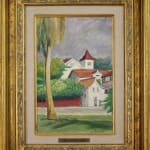John Lyman Canadian, 1886-1967
Further images
This painting, entitled Dixie Bar, Paramaribo, Suriname, created by John Lyman around 1962, offers a glimpse into a tranquil moment in a tropical setting. The artwork features a collection of buildings, presumably part of the Dixie Bar in Paramaribo, painted with a soft, almost dreamlike quality.
The architecture has a colonial flair, as seen in the pointed roof and clock tower that rise above the rest, painted in a palette of whites and creams that stand out against the surrounding greenery. The foreground is occupied by a tall, slender tree on the left, its foliage depicted in quick, impressionistic strokes that convey the lightness of the leaves. The grass is rendered in a light, muted green, suggesting an open space in front of the buildings. The sky, a muted combination of grays and whites, hints at an overcast day, which casts a gentle diffuse light on the scene, allowing for soft shadows and subtle contrasts. There is no direct sign of the hustle and bustle typically associated with bars; rather, the scene is serene and devoid of people, suggesting a moment of quiet before or after the daily activity.
Lyman's brushwork is fluid, with a somewhat relaxed precision that captures the essence of the structures and their environment. The painting is a blend of representation and abstraction, capturing not just the visual details of the scene but also the atmosphere and mood of this corner of Suriname in the early 1960s.






